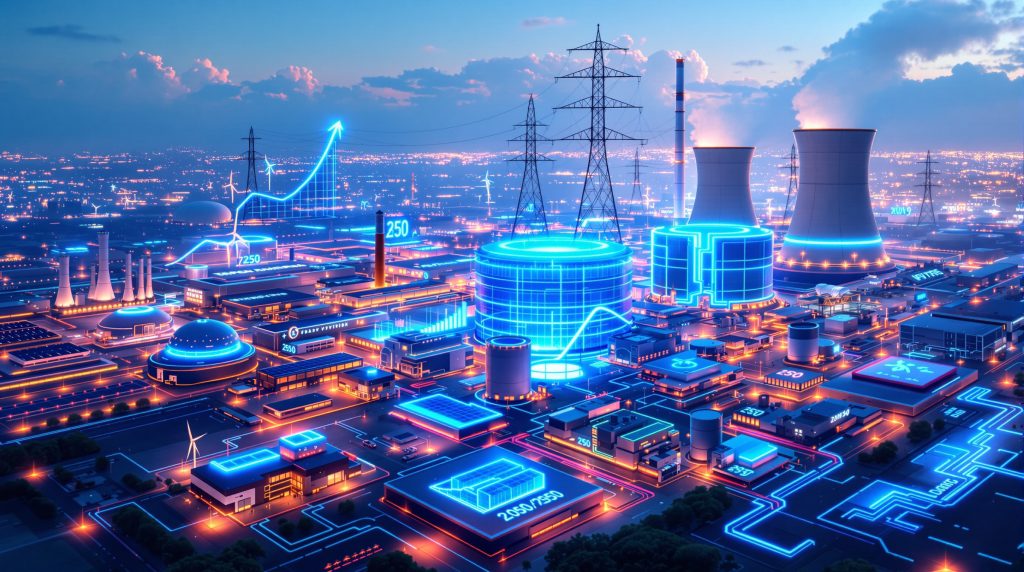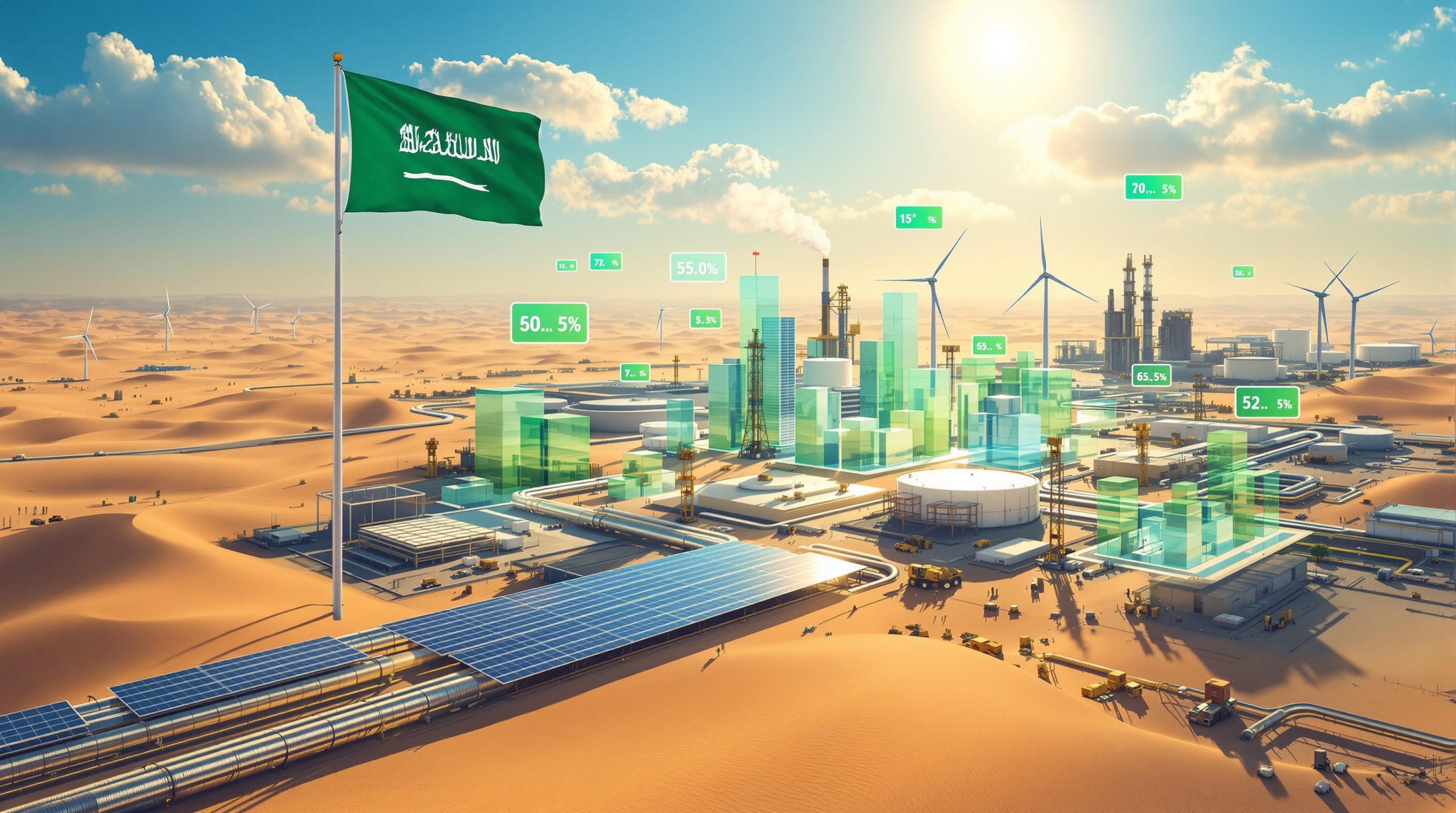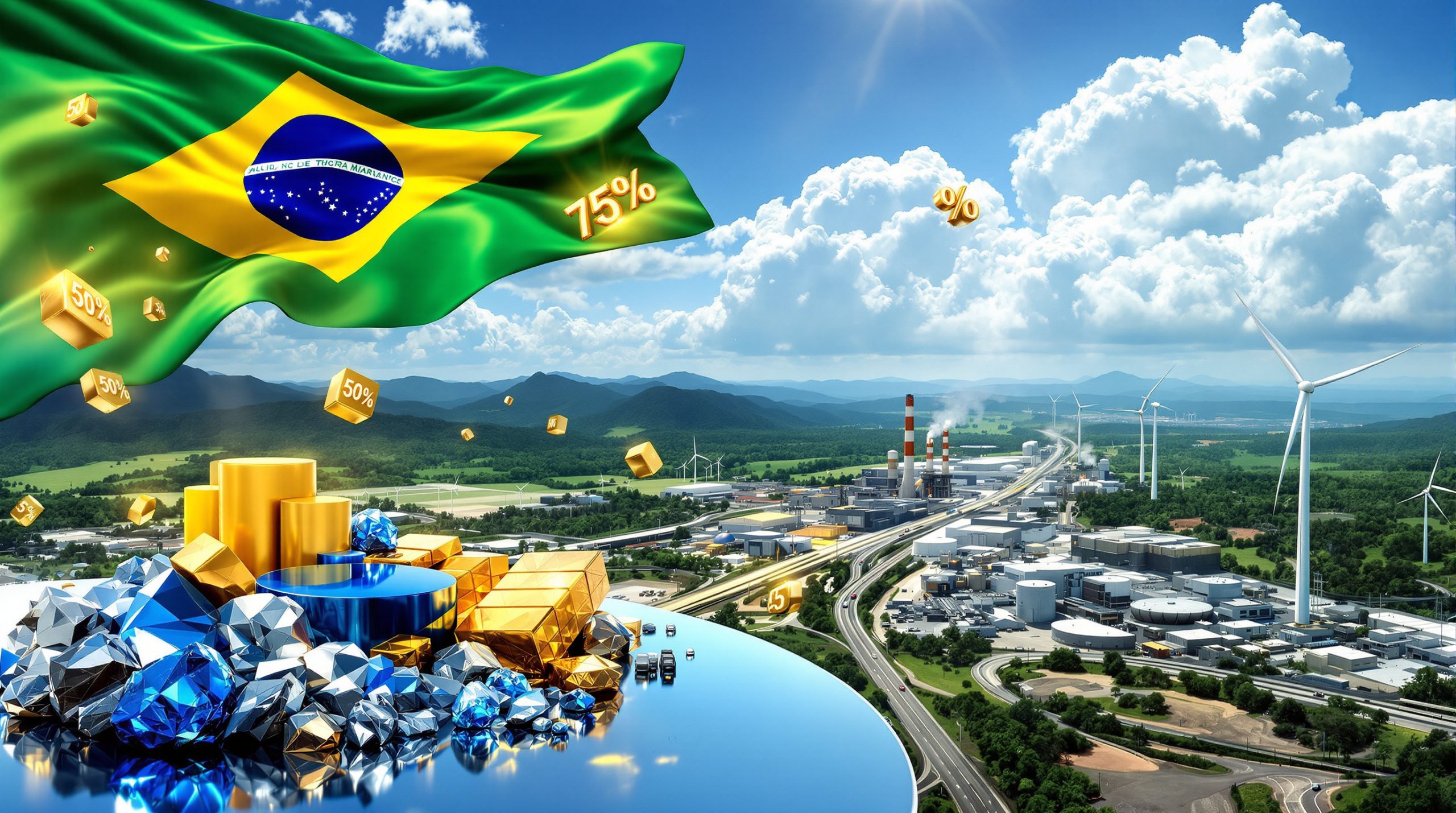Nuclear Energy Demand Growth: Powering the Future Through 2050
Nuclear energy is experiencing a significant resurgence globally, with projections indicating substantial growth through 2050. After decades of relatively flat development following the Fukushima accident in 2011, nuclear power is now positioned for expansion driven by increasing electricity demands, decarbonization goals, and the need for reliable baseload power.
Current global nuclear capacity stands at approximately 380 GW, with projections suggesting this could increase to around 575 GW by 2040. Some high-growth scenarios even project a potential 2.5-fold increase by 2050, representing a fundamental shift in the global energy landscape as countries reassess nuclear's role in their energy strategies.
What's Driving the Renewed Interest in Nuclear Power?
Climate Change Imperatives
The urgent need to reduce carbon emissions has repositioned nuclear energy as a critical component of global decarbonization strategies. As a zero-carbon electricity source during operation, nuclear power offers a path to meet climate goals while maintaining grid reliability.
Nuclear energy's carbon footprint is comparable to renewable sources like wind and solar when measured across its full lifecycle, making it an attractive option for countries committed to net-zero targets. The technology provides consistent, reliable power without the intermittency challenges associated with weather-dependent renewables.
Surging Global Electricity Demand
Electricity consumption is growing at an unprecedented rate, outpacing overall energy use growth. Global electricity demand is projected to increase by more than 50% between 2022 and 2040, driven by several factors:
| Demand Driver | Impact on Electricity Consumption |
|---|---|
| Population Growth | From 8 billion to nearly 10 billion by 2050 |
| Urbanization | Increasing energy-intensive urban populations |
| Industrialization | Expanding manufacturing bases in developing economies |
| Digitalization | Growing data center and AI infrastructure needs |
| Electrification | Transportation and heating shifting from fossil fuels to electricity |
This dramatic increase in electricity demand requires massive expansion of generation capacity, creating opportunities for nuclear energy demand growth alongside other clean energy sources.
Data Center and AI Revolution
One of the most significant emerging drivers for nuclear energy demand is the explosive growth in data centers and artificial intelligence infrastructure. These facilities require enormous amounts of reliable, 24/7 electricity:
- Data center electricity demand in the U.S. alone could increase five-fold by 2035
- AI systems require 10-100 times more energy than traditional computing
- Tech companies are increasingly seeking clean, reliable power sources for their operations
This surge in power-intensive computing creates a natural partnership with nuclear energy, which can provide the consistent baseload power these facilities require without carbon emissions.
Which Regions Are Leading Nuclear Energy Growth?
Asia's Nuclear Ambitions
Asia represents the epicenter of nuclear growth, with China leading global expansion efforts:
- China plans to increase its nuclear capacity from approximately 55 GW to 150 GW by 2035
- India aims to triple its nuclear capacity by 2032
- South Korea has reversed previous phase-out policies and is now expanding its nuclear fleet
- Japan continues to restart reactors that were shut down after Fukushima
These Asian economies view nuclear power as essential to meeting their growing electricity demands while reducing reliance on imported fossil fuels and addressing air pollution concerns.
North American Renaissance
After decades of limited development, North America is experiencing renewed interest in nuclear energy:
- The United States is extending the lifespans of existing plants while supporting advanced reactor development
- Canada is investing in small modular reactor (SMR) technology
- Both countries are providing significant government funding and regulatory support for new nuclear technologies
This resurgence is driven by recognition of nuclear's role in grid stability, energy security, and meeting climate goals, particularly as electricity demand from data centers and electrification increases.
European Mixed Approaches
Europe presents a complex picture of nuclear energy development:
- France continues to rely heavily on nuclear power (providing approximately 70% of its electricity) and plans to build new reactors
- The UK is developing new nuclear projects to replace aging plants
- Eastern European countries like Poland and the Czech Republic are pursuing new nuclear capacity
- Germany completed its nuclear phase-out in 2023, though debates continue about this decision
The energy crisis following Russia's invasion of Ukraine has prompted many European countries to reconsider nuclear power as a means to enhance energy security and reduce dependence on imported natural gas.
What Role Will Advanced Nuclear Technologies Play?
Small Modular Reactors (SMRs)
SMRs represent one of the most promising avenues for nuclear expansion:
- Typically ranging from 50-300 MW capacity (compared to 1,000+ MW for conventional reactors)
- Factory-built modules that can be transported to sites, reducing construction complexity
- Scalable deployment allowing for incremental capacity additions
- Enhanced passive safety features requiring minimal operator intervention
- Potential for reduced capital costs and construction timeframes
Several SMR designs are advancing through regulatory approval processes in the U.S., Canada, and other countries, with commercial deployments expected in the late 2020s, according to industry experts.
Microreactors for Distributed Power
Even smaller than SMRs, microreactors (1-20 MW) offer unique capabilities:
- Suitable for remote locations, military installations, or industrial facilities
- Transportable units that can be deployed where traditional grid connections are unavailable
- Potential for replacing diesel generators with zero-carbon alternatives
- Minimal staffing requirements due to autonomous operation capabilities
These compact reactors could open entirely new markets for nuclear energy beyond traditional grid-scale applications.
Advanced Large Reactors
Innovation isn't limited to smaller designs. Next-generation large reactors incorporate:
- Enhanced passive safety systems
- Higher thermal efficiency
- Improved fuel utilization
- Reduced waste production
- Longer operational lifespans
These advanced large reactors aim to address economic challenges while maintaining the economies of scale that benefit larger facilities.
What Are the Economic Implications of Nuclear Growth?
Investment Requirements
The projected growth in nuclear capacity will require substantial investment:
- Estimated $1-1.5 trillion in global investment needed by 2050 for nuclear expansion
- Individual large reactor projects typically cost $10-15 billion
- SMR projects aim for lower capital costs but remain capital-intensive
This investment challenge requires innovative financing mechanisms, government support, and recognition of nuclear's long-term value proposition.
Lifetime Economics
Despite high initial costs, nuclear plants offer compelling economics over their operational lifetimes:
- 60-80 year operational lifespans (with appropriate maintenance and upgrades)
- Very low fuel costs relative to total electricity production
- Minimal price volatility compared to fossil fuel generation
- High capacity factors (typically 90%+) maximizing return on investment
When evaluated over their full lifetime and accounting for system-wide benefits, nuclear plants often represent cost-effective electricity generation options.
Job Creation and Economic Development
Nuclear energy development creates substantial economic benefits:
- Each nuclear plant typically employs 400-700 permanent, high-skilled workers
- Construction phases employ thousands of workers
- Nuclear jobs pay significantly above average wages
- Local economic multiplier effects benefit surrounding communities
- Domestic manufacturing opportunities for components and fuel
These economic benefits extend beyond electricity production to create broader prosperity in regions hosting nuclear facilities.
What Challenges Could Limit Nuclear Energy Growth?
Financing and Project Execution
Historical challenges with cost overruns and schedule delays have created investor wariness:
- Recent projects in Western countries have experienced significant budget increases
- Construction timelines have extended beyond initial projections
- Financing large, long-term projects remains difficult in liberalized electricity markets
Addressing these challenges requires standardized designs, improved project management, and supportive policy frameworks that recognize nuclear's unique attributes.
Public Perception and Social License
Public acceptance remains variable across different regions:
- Some countries maintain strong public support for nuclear energy
- Others face significant opposition based on safety concerns
- Waste management solutions exist but often face political challenges
- Educational efforts are needed to address misconceptions
Building and maintaining social license requires transparent communication, community engagement, and demonstrated commitment to safety and environmental responsibility.
Skills and Knowledge Gap
A critical challenge facing the industry is the loss of expertise and knowledge:
- In the 1970s, approximately 25,000 people worked in the uranium industry in the United States, producing about 45 million pounds of uranium annually
- Today, only 500-600 people work in the U.S. uranium industry
- The knowledge gap created by decades of limited development requires significant training and mentorship programs
- New talent must be attracted to rebuild the specialized workforce needed for expansion
This skills gap could potentially constrain growth if not addressed through coordinated industry and educational initiatives.
Regulatory Frameworks
Regulatory processes designed for traditional large reactors may impede innovation:
- Licensing processes can be lengthy and costly
- Regulations may not be well-adapted to new technologies
- International harmonization of standards remains limited
- Regulatory capacity constraints exist in countries new to nuclear energy
Modernizing regulatory approaches while maintaining safety standards is essential for enabling nuclear growth, particularly for advanced designs.
How Will Nuclear Energy Interact with Other Clean Energy Sources?
Complementary Roles with Renewables
Rather than competing, nuclear and renewable energy sources can play complementary roles:
- Nuclear provides baseload power while renewables generate when resources are available
- Nuclear can reduce the need for fossil fuel backup generation during renewable intermittency
- Combined systems can achieve deeper decarbonization than either technology alone
- Grid stability improves with diverse generation sources
This complementary relationship is increasingly recognized in system planning and policy development.
Hydrogen Production Opportunities
Nuclear plants can produce hydrogen during periods of excess electricity:
- High-temperature reactors can produce hydrogen more efficiently than electrolysis
- Hydrogen production provides flexibility and additional revenue streams
- Nuclear-produced hydrogen offers a zero-carbon pathway for hard-to-decarbonize sectors
- Existing nuclear plants can be retrofitted for hydrogen co-production
This synergy between nuclear and hydrogen economies creates additional value propositions for nuclear facilities.
Heat Applications Beyond Electricity
Nuclear energy's value extends beyond electricity to include process heat applications:
- Industrial processes requiring high temperatures
- District heating systems
- Desalination of seawater
- Chemical manufacturing
These non-electric applications represent growing markets for nuclear energy, particularly as industries seek to decarbonize their heat sources.
What Does the Future Hold for Uranium Markets?
Supply-Demand Dynamics
Current uranium production falls well short of consumption:
- Global uranium production: approximately 48,000 tonnes annually
- Annual consumption: approximately 65,000 tonnes
- Difference currently met through secondary supplies and inventories
This structural deficit is expected to widen as nuclear capacity expands, creating strong fundamental support for uranium market volatility.
Price Incentives for New Production
Higher uranium prices will be necessary to stimulate new production:
- Current spot prices remain below the level needed for many new mining projects
- Legacy deposits with favorable economics are being developed first
- Higher-cost resources will require sustained price increases
- Long lead times for new mines (often 10+ years) create potential supply constraints
Industry experts note that today's uranium prices of $75-80 per pound may be sufficient for existing producers with paid-off infrastructure and previously discovered deposits, but are inadequate to fund new exploration and development. When adjusted for inflation, uranium prices in the late 1970s of $40-43 per pound would be equivalent to approximately $150 per pound in today's dollars.
Historical Context and Future Implications
The uranium industry has undergone significant structural changes:
- In the 1970s, the U.S. alone had 25,000 people working in uranium production, generating about 45 million pounds annually
- The sector subsequently contracted dramatically, losing considerable expertise and knowledge
- Current production relies heavily on "legacy assets" that were discovered and developed decades ago
- Future production will require substantial new exploration and development
Industry experts warn that the market is not yet pricing in the full cost of bringing new pounds of uranium into production, especially considering the complete lifecycle from exploration through mining and eventual reclamation.
Geographical Diversification
Uranium production is becoming more geographically diverse:
- Kazakhstan currently dominates global production (approximately 40%)
- Canada, Australia, Namibia, and Uzbekistan represent other major producers
- New projects are advancing in various jurisdictions worldwide
- Security of supply concerns are driving interest in domestic production in some countries
This diversification helps mitigate geopolitical risks and enhances the resilience of the nuclear fuel supply chain.
The Rising Importance of Jurisdictional Security
Reducing Dependency on Russian Supply
The geopolitical landscape has shifted focus toward secure supply chains:
- Western countries are actively working to reduce dependence on Russian uranium supplies
- Bipartisan political support in the United States is focusing on domestic uranium production
- New policies are encouraging the development of domestic supply chains for nuclear fuel
This emphasis on jurisdictional security is creating opportunities for uranium investment strategies in politically stable regions, even if they have higher production costs than some international alternatives.
Exploration Renaissance
After years of limited investment, uranium exploration is experiencing renewed interest:
- Companies are revisiting historic uranium districts with modern exploration techniques
- New geological targets are being tested, moving beyond traditional radiometric anomalies
- Systematic exploration approaches are being applied to discover the next generation of deposits
- Investment in exploration is increasing, though still below levels needed for long-term supply security
The challenge remains finding high-quality deposits that can sustain production over decades, particularly as many of the "low-hanging fruit" deposits have already been discovered and developed.
Conclusion: Nuclear's Expanding Role in the Energy Transition
Nuclear energy stands at an inflection point, with growing recognition of its essential role in addressing climate change while meeting increasing electricity demands. The projected growth—potentially doubling or even tripling global capacity by 2050—represents a fundamental shift from the limited development of recent decades.
This expansion will be driven by a combination of traditional large reactors and innovative designs like SMRs, supported by growing policy recognition of nuclear's value proposition. While challenges remain, particularly around financing and public acceptance, the fundamental drivers for nuclear growth appear stronger than at any point in the past several decades.
As electricity demand continues its unprecedented growth, particularly from data centers and electrification, nuclear energy's ability to provide reliable, zero-carbon power positions it as a critical component of the future energy system. The coming decades are likely to see nuclear energy playing an increasingly important role in the global energy transition, working alongside other clean energy technologies to create a sustainable, reliable, and affordable electricity system.
However, the industry must navigate significant challenges, including US uranium tariff risks and ongoing uranium mining halts in key regions. Nevertheless, there are positive indicators for the sector, such as the anticipated US uranium production surge that could help address supply concerns over the coming years.
Disclaimer: This article contains forward-looking statements regarding nuclear energy demand, uranium markets, and technology development. Future outcomes may differ from projections due to regulatory changes, technological developments, market conditions, or other factors. Readers should consult with qualified financial and energy advisors before making investment decisions based on this information.
Want to Invest in the Next Major Uranium Discovery?
Stay ahead of the market with real-time alerts on significant ASX uranium discoveries, powered by Discovery Alert's proprietary Discovery IQ model. Explore why historic mineral discoveries can generate substantial returns by visiting the Discovery Alert discoveries page and begin your 30-day free trial today.




